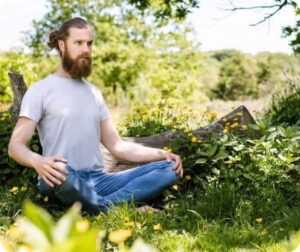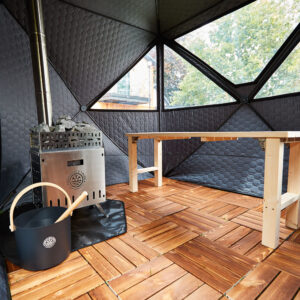
Ice Baths: A Key to Enhanced Recovery and Vitality for Athletes
Explore how ice baths can boost recovery and enhance vitality for athletes. Discover practical tips and insights to elevate your performance. Read more!
Spend Over £500 To Get Free UK Delivery - Excludes Certain Postcodes & Round Ice Baths

The therapeutic power of sound and movement has been used by different civilizations for thousands of years as a way of treatment. All of these techniques, whether they a
In this post, we shall look at eight things that you (probably) didn’t know about movement and sound healing.
Sound and movement therapy has been shown to be effective for a range of conditions, including but not limited to:
One of the most elaborate uses of sonic resonance is that found in Ancient India where Tantric chants invoked five sounds called ‘the 5 Ms’: mātra (space), mantra (sound), mudrā (gesture), manas (thought) and maithuna (sexual union) to enable practitioners to travel through different dimensions. The Mayan civilization did something very similar, using rhythmic chanting accompanied by specific forms of movement to achieve similar results. In modern times, indigenous peoples, such as the Jivaro shamans or curandera healers continue to use these same methods for healing purposes.
According to many metaphysical concepts, sound is the first form of energy that permeates throughout the entire universe. This makes sound an incredibly powerful tool for healing and transformation at all levels. Think about it: sound can do things such as vibrate objects which in turn creates heat or light (e.g., fire) and even causes physical matter to move around (e.g., earthquakes). The power of sound has been well-documented by science too: we know that singing bowls generate vibrations causing molecules inside the water to align and become more concentrated and we also know that specific sounds can shatter glass or dissolve kidney stones!
At least 2 known indigenous cultures whose healers use sound and movement to ‘tune-up’ the physical body are the Druids of Europe and Amazonian shamans, called cureís. Their methods include chanting, dancing, drumming or playing flutes in specific sequences to heal individuals through aligning human breath with hemispheric brain waves.
According to ancient Chinese philosophy, life is a process of becoming homeostasis by bringing polarities into equilibrium which then creates things like health or beauty or love on earth. This also means that whenever there is an imbalance in these polarities (or energies), it must be corrected so that everything can return back to balance, which is what movement therapy claims to do.
S bowls are used to trigger the vibrational healing effect of sound
The most famous use of Tibetan bowls is in the relaxation response, a flow of energy that helps rebalance our central nervous system after stressful situations.
Various studies have shown us that sound vibrations can affect cells at the molecular level, which is one of the reasons why some people believe they can cure cancer. The following video shows how Tibetan singing bowls produce life-enhancing frequencies by using harmonic overtones that coincide with the fundamental note being played.
A simple way to get started with sound healing is by tuning forks! These are great for helping shift any stuck energies in your body and bringing things back into equilibrium via specific sound frequencies. Other ways to use sound and movement in hands-on therapies include Reiki Healing Touch Yoga Music Therapy Qigong Tai Chi.
As you can see, sound and movement go hand in hand to create a more harmonious state of being.
Sound therapy is a holistic therapy that uses sound, movement and energy for healing purposes. The ancient practices of using singing bowls or drums to facilitate meditation in Eastern cultures have been widely adapted by psychologists and other healthcare professionals to help people relax and focus attention on their inner selves. Sound healing therapy delivers sound frequencies and sound vibrations at a vibrational frequency designed to stimulate our bodies and minds through sound waves that can help to ease chronic pain, support treatment of mental health issues, improve physical health and illicit the body’s healing response. Healing vibrations promote relaxation, can reduce high blood pressure and anxiety, create deep relaxation and emotional balance through internal healing.
Sound healing therapy can be delivered in sound baths, sound chambers, through music therapy sessions by a trained practitioner experienced with sound healing work and the ability to tap into the many health benefits of sound healing. There are many benefits of sound healing, it is common to find inner peace and a state of relaxed consciousness from the healing powers of sound healing that often modern medicine cannot deliver. Sound healing is great for reducing stress, releasing stuck energy, removing energetic blockages, it can reduce inflammation and enable more energy, increase focus, boost morale and mood and reduce muscle and bone pain.
Sound healing therapy is a great way to treat individuals suffering from anxiety, stress or sleeping problems. It is also beneficial in cases of depression, Alzheimer’s disease or when overcoming addictions. Music has the power to elicit emotions which can be used as well when treating these conditions!
In addition, many therapists use sound healing therapy with children who suffer from learning disabilities such as autism or who simply have trouble paying attention in class.
Treatment with sound therapy can be both a passive and a participatory experience. With regard to the passive part, you will become calmer by lying down and slowing your breathing. You are preparing yourself to take on the role of the receiver of sound by doing so. When you are in this state of stillness, you can take part in the process by being more open and aware of each sound that enters. Sound, in the same way that a mantra assists you in arriving at the quiet point of meditation, helps to pave the way to this region of silence and tranquillity.
When we experience acute pain and suffering, we are referring to the physical body. In order to increase the release of Nitric Oxide, a free radical molecule that has been shown to positively influence pain transmission and regulation, we can use tuning forks, particularly osteoporotic tuning forks which vibrate at lower frequencies. To put it another way, these frequencies aid in the production of a physiological response, while the sound itself aids in the influence of our auditory system, allowing us to alter our connection with pain.
Our energetic body is referred to as our “subtle body” This is the location of our life force energy, which is referred to as Qi, Chi, or prana in various cultures. In Chinese medicine, meridian points are used to identify regions where energetic flow to our physical and subtle bodies has been blocked in order to treat them. A large number of these meridian lines are known to exist in the body, and they are mapped out through the body in the same way that we have mapped out the latitude and longitude of the world. The subtle body contains imbalances and traumas that might eventually appear in our physical bodies, which is why it is necessary to approach healing and balance from a holistic perspective that incorporates the mind, body, and spirit.
To tune other instruments, tuning forks are commonly employed as a tuning tool. They do, however, possess healing abilities of their own. In order to send vibrations to specific portions of the body, tuning forks must be calibrated. Vibrations can be sent to release tension and open blocked energy channels. This type of sound healing is beneficial for restoring emotional equilibrium as well as pain relief.
Since circa 4,000 B.C., gongs have been utilized as a kind of sound healing to promote healing. They are now being utilized in gong baths. When practicing this kind of meditation, the practitioner uses gongs to produce varied tones and patterns, which then produce vibrations that help to strengthen the mind-body connection. In addition, it is quite fast.
The gong’s size and structure enable it to produce more powerful vibrations and a far more resonant sound. Within 60 to 90 seconds, the sound can send you into profound relaxation and meditative Theta state, according to the researchers.
Gong baths are excellent for releasing phobias or emotional obstacles, as well as for boosting mental clarity, and they can leave you feeling transformed on both a physical and mental level.
The sound wave passing through the body stimulates red blood cells, thereby increasing blood supply to all organs and throughout the body. Aside from that, gongs activate the limbic system, which causes your muscles to relax. Hearing the gong is accomplished through the ears, which transmits the sound through the auditory nerve and then the vagus nerve, stimulating every organ in the body. All of your organs, particularly your liver and kidneys, will function more efficiently. It is possible to wake up feeling refreshed and re-energized.
A sound bath consists of sound vibration therapy, sound healing, and vibrational sound therapy. They are an immersive sound meditation. A sound bath may be enjoyed by people who cannot practice other forms of meditation because they somehow don’t do well with sitting still and quieting their minds. By taking deep breaths and listening to the sound of vibrational instruments, anyone can enjoy a sound bath and find relaxation and peace within themselves. What is particularly interesting about this style of meditation is that it allows for freedom, instead allowing you to move around while concentrating on the sounds played during the session. Some choose to sit up or lay down, while others like to walk around slowly, allowing themselves to move freely without interruption from thoughts such as “I should be sitting still” or other negative feelings that can get in the way of your experience. The breathing techniques used during sound baths help to ensure that you are able to relax and calm the mind, body, and spirit. Although this is a type of meditation, it should not be confused with traditional meditation.
One of the most common benefits of sound healing therapy is its ability to produce relaxation. Relaxation has been shown to help people who are dealing with psychological issues, including depression and post-traumatic stress disorder (PTSD). The treatment can be used on children as young as three years old.
Sound therapy is also useful for pain relief. A study was conducted that focused on 146 patients who had experienced whiplash injuries. The patients were split into two groups, one of which practiced meditation using ancient Tibetan singing bowls, while the other group engaged in simple relaxation exercises. After eight weeks, the results showed that there were significant differences between the two groups; 50% of those who engaged in meditation reported feeling “very much improved,” compared with only 5% of those who engaged in relaxation exercises. In addition, the researchers found that the meditation group experienced a 50% reduction in depression as well as pain.
In another study, sound therapy was found to have been effective for treating Parkinson’s disease. Researchers discovered that focused-attention meditation helped participants improve their mental function and emotional health while alleviating the symptoms of fatigue and apathy.
Sound therapies can be used to treat a variety of issues including learning disorders, mental illnesses, Post Traumatic Stress Disorder (PTSD), substance addiction or withdrawal, Spiritual Emergency/psychospiritual crisis, stress management and sleep disorders.
Movement therapy is a technique in which the client moves to the rhythm of the music, and practitioners often utilise movement for healing. Music can be used in many different ways to help with this process including drumming circles, rapping and poetry, yoga and other types of meditative practices that involve repetitive movements such as Tai Chi and Qi Gong. Movement therapy has been shown to be beneficial for mood disorders such as depression, anxiety, adjustment disorder and many others.
People who practice movement therapy regularly have better memory functions than those who do not exercise at all. One study found that when participants engaged in 90-minute aerobic exercise four times per week over an eight-week period, they experienced significant improvements in their long term memory function. This improvement was found to be equal to that experienced by participants who engaged in an aerobic exercise program twice per week for 16 weeks.
Another study examined the effects of movement therapy on improving cognitive functioning in adults with mild cognitive impairment (MCI). The results showed that after 12 months, participants were less likely to progress from MCI into Alzheimer’s disease or other types of dementia.
The psychological benefits of movement are numerous in addition to the physical benefits of moving around. Exercise is a natural antidepressant because it stimulates the endocannabinoid system while also up-regulating neurotransmitters connected with the brain’s reward system. The ‘runners high’ is an example of how exercise can provide a psychological boost that is felt immediately after the activity. Considering that the brain is a component of the body, providing the body with regular exercise is one of the most effective strategies to protect and improve our psychological well-being. Exercising has numerous psychological advantages in addition to physiological ones. These advantages include improved self-esteem and self-discipline, as well as greater energy to devote to other aspects of our lives.
When we were children, one of our most primal drives was to play. The same is true for all animals, and it serves as our primary method of teaching as we grow older. As adults, we have fewer opportunities for play; yet, physical activity is still an option for people who want to engage in a fun activity, whether it is through team sports or individual activities like climbing. Play is much more than a frivolous way to pass the time. It is a way of life. When we are having a deep, meaningful experience of life, play is essential to feeling that way. It also serves as a means of learning about ourselves and our environment. The act of moving our bodies allows us to relive the feelings of joy and playfulness that we remember from our youth but frequently miss as adults. The ability to express ourselves through our body, as well as the potential to share this experience with others, comes from becoming in tune with ourselves.
Studies show that physical movement can help with different psychiatric conditions such as depression, anxiety and stress management. Movement therapy has also shown efficacy to improve neuropsychological functioning in those who have problems such as mild cognitive impairment (MCI) and Alzheimer’s disease.
“Attention Restoration Theory” by Kaplan and Berman states: “Attention requires an intentional focusing of our mental faculties on a particular task or stimulus so as to filter out other distractions”. This theory suggests that we lose focus because we are overwhelmed with all the information we take in every day. We need time to clear our minds and allow ourselves to be guided by something relaxing like music, nature sounds or soft voices.
Contemporary research suggests that EFs are not synonymous with cognitive processes or mental abilities, but rather they represent an integrative set of skills. These skills allow people to plan, prioritize and solve problems in various situations. EFs can be improved through physical exercise that is challenging enough to stimulate these functions, yet gentle enough to support their improvement without causing stress.
There is evidence that movement therapies such as yoga increase attention levels in children with Autism Spectrum Disorders (ASD). Yoga was found to improve certain symptoms associated with ASD including social interaction, social withdrawal and hyperactivity. The use of dance-movement therapy was also found to have a positive effect on the quality of life of adolescents diagnosed with ASD.
Physical exercises can be helpful to improve sleep quality in older adults by reducing both total time of the night’s sleep as well as awakenings during the night. Studies have shown that aerobic fitness activities are also associated with better quality of life, reduced depression and increased self-esteem in older adults. Yoga has been found to reduce insomnia symptoms among Chinese women who were diagnosed with moderate to severe insomnia, which was measured by an Insomnia Severity Index (ISI). The findings suggest that yoga may help relieve insomnia symptoms for middle-aged women at moderate risk for developing mild cognitive impairment or Alzheimer’s disease due to chronic insomnia. It is important to note that research shows that exercise is only effective when it is done with consistency.
It has been found that physical activity can decrease pain levels, anxiety and depression among cancer patients. There are also indications that it enhances body image perception, self-esteem and mood among these individuals. Yoga has shown to improve both musculoskeletal (MSK) system functions like posture, movement coordination and flexibility as well as the general wellbeing of people suffering from cancer. Breast cancer survivors who incorporate yoga into their lifestyle experience fewer depressive symptoms than those who don’t practice yoga. Clinical studies have also shown that movement therapies like dance/movement therapy enhance quality of lifeFACT-G), mood (Global Mood Scale-GMS) and relaxation (State Anxiety Inventory-STAI).
Parents who choose to give their child an alternative treatment like yoga report lower levels of stress. Yoga has proven to be effective in managing ADHD symptoms by increasing sensory regulation, impulse control, auditory processing and time management issues among these individuals. Yoga can also help children learn self-regulation skills that will benefit them during school hours.
It is important to note that research shows that exercise is only effective when it is done with consistency.
Moving away from the idea of using complementary medicine treatments as possible alternatives or supplements for other forms of medical treatment, it should be considered that these methods represent an integrative set of skills that can help people treat specific health problems or manage certain symptoms. While complementary medicine is often considered as separate from conventional medicine, it should be noted that the concepts within both disciplines are meant to complement each other in order to provide complete treatment for the individual patients.
It has been found that physical activity can decrease pain levels, anxiety and depression among cancer patients. There are also indications that it enhances body image perception, self-esteem and mood among these individuals. Yoga has shown to improve both musculoskeletal (MSK) system functions like posture, movement coordination and flexibility as well as the general wellbeing of people suffering from cancer. Breast cancer survivors who incorporate yoga into their lifestyle experience fewer depressive symptoms than those who don’t practice yoga. Clinical studies have also shown that movement therapies like dance/movement therapy enhance quality of lifeFACT-G), mood (Global Mood Scale-GMS) and relaxation (State Anxiety Inventory-STAI).
Studies have found a link between Parkinson’s disease and genetic risk factors linked to a lack of physical activity. A decline in the body’s dopamine levels is related to the onset of symptoms typically associated with Parkinson’s disease, such as muscle rigidity, slowness or stiffness. Studies show that there is a decrease in physical activity among individuals diagnosed with Parkinson’s disease when compared to healthy adults without the condition, which may be one reason for this decline in dopamine levels. In addition, studies have found a link between physical activity and gene expression. People who are considered to be “high active” were shown to have different changes in muscle and immune system genes than people who were categorized as “low active”.
Studies show that an increase in the duration of physical activities like yoga can lead to improved quality of life. Retired individuals with mild cognitive decline (MCI) following an eight-week course of yoga classes scored higher on tests assessing aspects such as memory recall, mental flexibility and problem solving when compared to their counterparts who did not participate in the programme. Yoga has also been found to improve musculoskeletal health among adults suffering from MCI and reduce stress levels among these individuals.
Moving away from the idea of using complementary medicine treatments as possible alternatives or supplements for other forms of medical treatment, it should be considered that these methods represent an integrative set of skills that can help people treat specific health problems or manage certain symptoms. While complementary medicine is often considered as separate from conventional medicine, it should be noted that the concepts within both disciplines are meant to complement each other in order to provide complete treatment for the individual patients.
According to Alexandra Chauran of Penn State University, “Feeling vital is partially about how we feel physically. But it’s also about having energy for what matters most in our lives…this is why self-care and relaxation are so important.” We spend so much time at work or doing other things that it can be hard to find the time to do something nice for ourselves. When we neglect this aspect of our lives, we deprive ourselves of one of the best methods for relieving stress, anxiety and depression. Asking others if they would like some form of movement therapy could go a long way toward improving relationships with the people around us. This activity could help them give their loved ones an opportunity to bond.

Founder of Urban Ice Tribe

Explore how ice baths can boost recovery and enhance vitality for athletes. Discover practical tips and insights to elevate your performance. Read more!

There’s nothing quite like the raw, elemental power of a pop-up sauna. Portable, authentic, and deeply restorative, it’s the perfect way to reconnect with nature and yourself. But to take your sauna ritual to the next level, the right sauna accessories can make all the difference.

Transform your outdoor space into a personal wellness retreat with the Urban Ice Tribe Sauna Tent. This detailed setup guide walks you through every step, from unboxing to your first steam session, blending practical instruction with the mindful ritual of heat therapy.
Helping men & women release anxieties & limiting beliefs to experience a life of freedom using powerful breathwork, cold water therapy, movement & sound healing.

No spam, notifications only about new products, updates, offers and announcements.